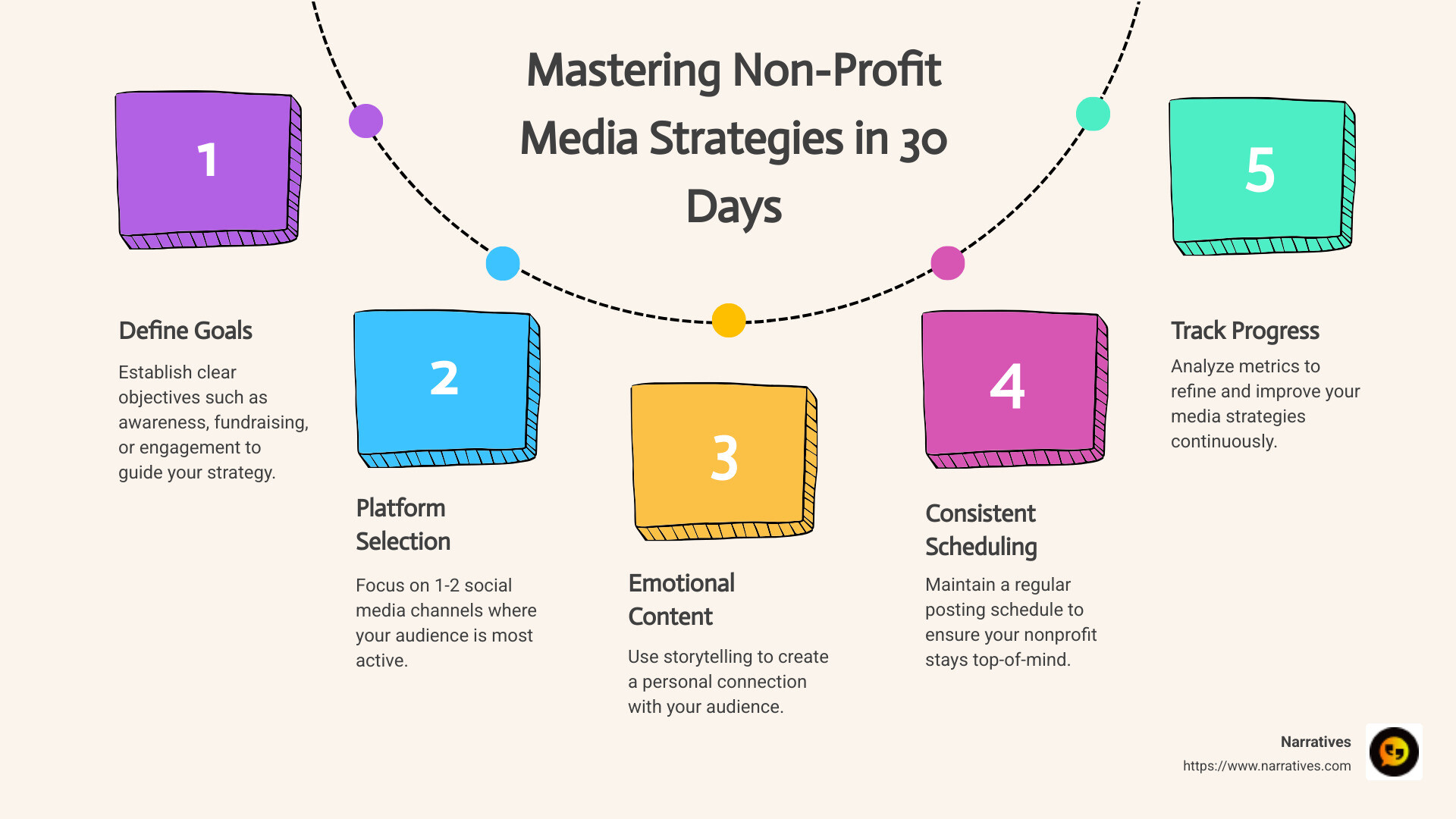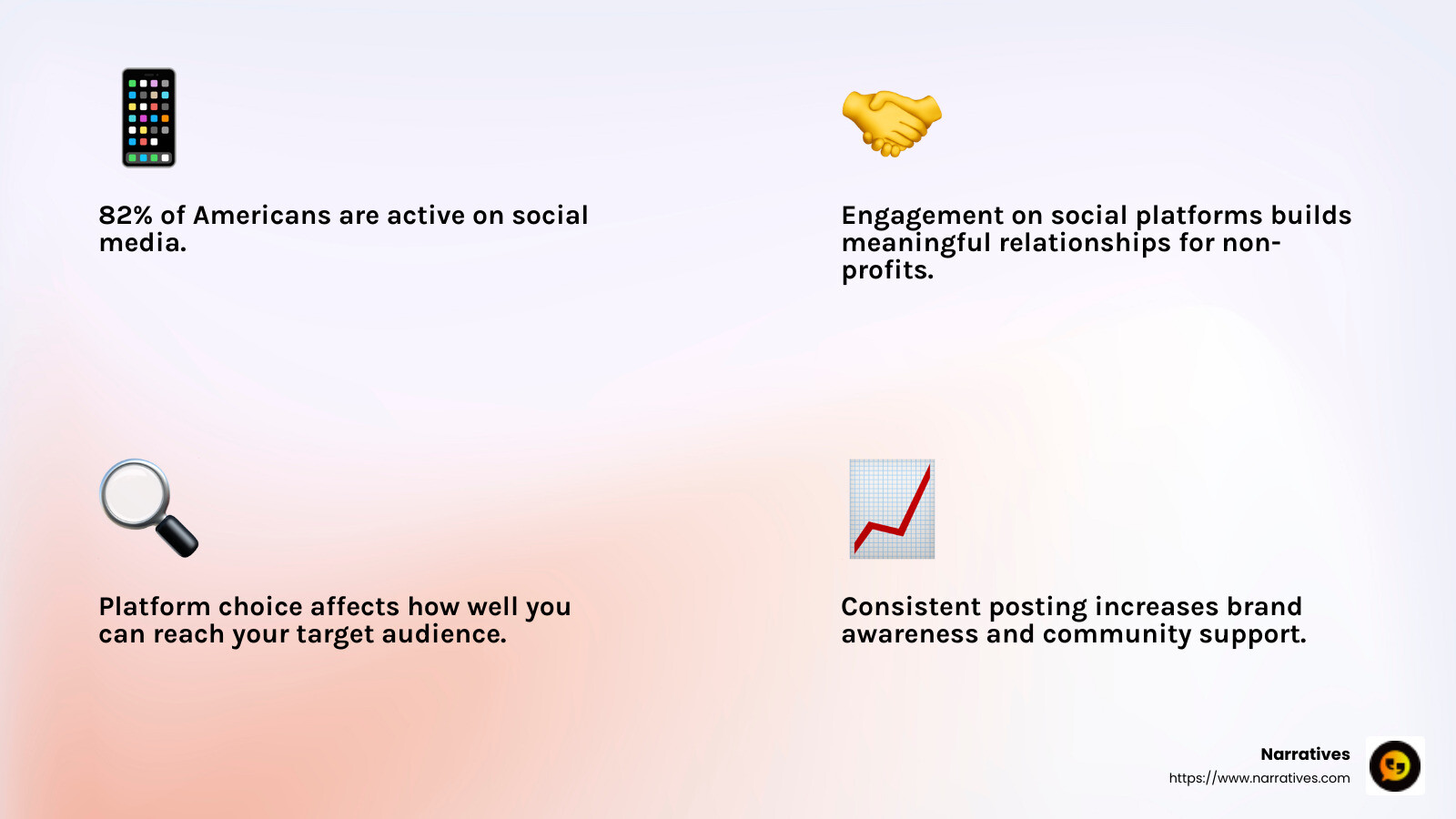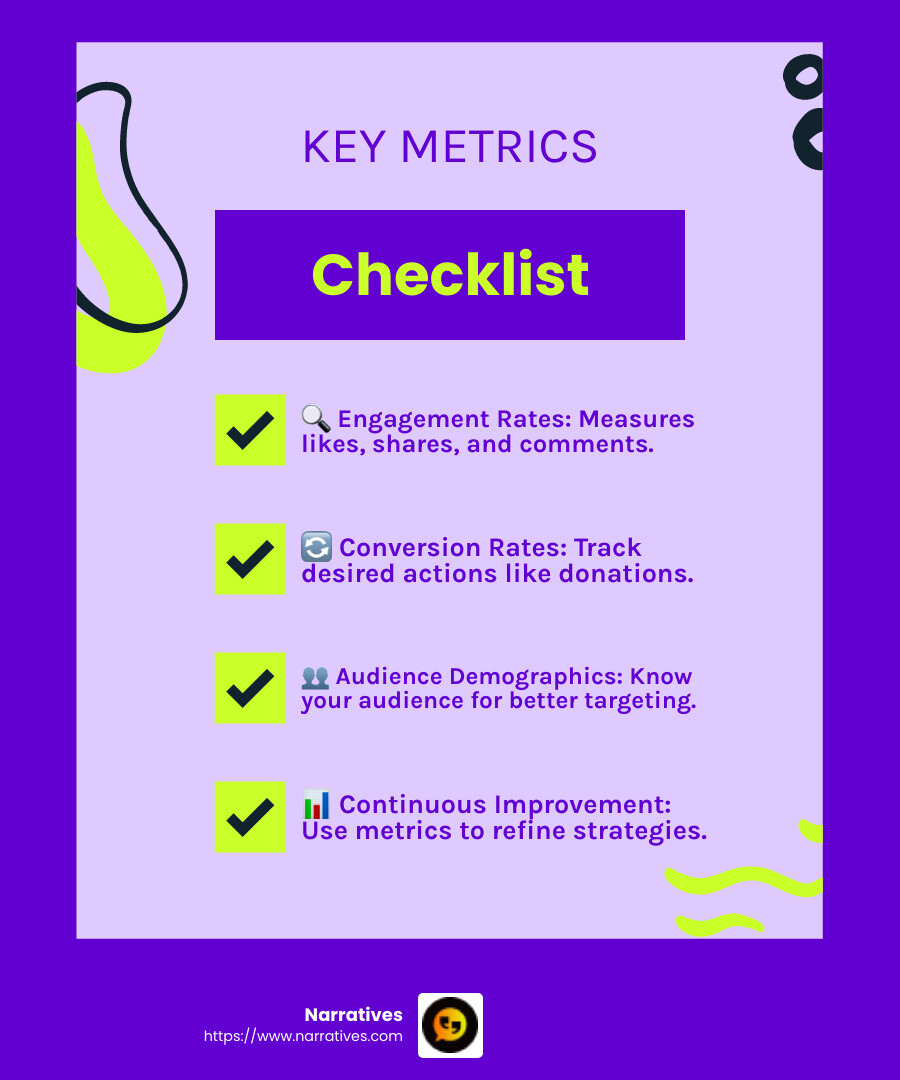How to Master Non-Profit Media Strategies in 30 Days

Non-profit media strategies are essential for organizations aiming to amplify their mission, drive donations, and reach broader audiences. Here's a quick guide to master these strategies effectively in 30 days:
- Define Clear Goals: Establish what you want to achieve—be it awareness, fundraising, or engagement.
- Choose the Right Platforms: Focus your efforts on 1-2 channels where your audience is most active.
- Craft Emotional Content: Use storytelling to connect with supporters personally.
- Implement Consistent Scheduling: Maintain a regular posting schedule to stay top-of-mind.
- Track Progress: Analyze metrics to refine and optimize your strategies.
In today's digital landscape, marketing isn't just a tool; it's the backbone of non-profit growth. Social media plays a pivotal role by offering a cost-effective platform for storytelling and relationship-building. With 82% of Americans actively using social media, your organization can meet supporters where they are. By strategically using these channels, you can engage with your community, drive awareness, and increase donations. A focused approach to selecting platforms and creating impactful content is key.

Understanding Non-Profit Media Strategies
Importance of Social Media
Social media is a powerhouse for non-profit organizations. It's not just about sharing updates; it's about building a community around your cause. With 82% of Americans using social media, your non-profit media strategies can reach a vast audience.
Engagement is crucial. Social media allows you to interact directly with your supporters. Whether it's through comments, shares, or direct messages, these interactions help build meaningful relationships. Brand awareness is another significant benefit. Consistent, strategic posting can keep your organization on your audience's radar.
Choosing the right platforms is essential. Each platform has its strengths:
- Facebook: Great for community building and detailed posts.
- Instagram: Perfect for visual storytelling and younger audiences.
- TikTok: Ideal for creative, short-form content that resonates emotionally.
- LinkedIn: Best for professional networking and sharing thought leadership.
Content Marketing for Non-Profits
A solid content strategy is vital for non-profits. It involves more than just posting regularly. It's about telling your story in a way that resonates with your audience and inspires action.
Storytelling is at the heart of this strategy. Share stories that highlight your mission's impact and the people you help. This not only engages your audience but also builds trust and credibility.
Audience engagement is key. Use polls, live events, and interactive content to involve your supporters. This not only keeps them engaged but also makes them feel like a part of your mission.
To drive donations, your content should include clear calls to action. Whether it's a "Donate Now" button or a link to your website, make it easy for supporters to contribute.
By focusing on these elements, your non-profit can effectively use social media and content marketing to achieve its goals. A well-crafted strategy that incorporates the right platforms, engaging content, and a clear call to action can significantly boost your organization's reach and impact.

Crafting a Social Media Strategy
Choosing the Right Platforms
Selecting the right platforms is the first step in crafting an effective social media strategy for your non-profit. Each platform offers unique features and caters to different audiences, so it's crucial to align your platform choice with your organization's goals and target demographics.
Facebook: With its extensive user base, Facebook is ideal for community building and sharing detailed updates. Use it for event information, fundraising pages, and live-streaming to offer a behind-the-scenes look at your organization.
Instagram: This platform thrives on visual content. It's perfect for showcasing the impact of your mission through photos and videos. Engage younger audiences with reels and stories that highlight your cause's emotional aspects.
TikTok: If targeting the younger generation is a priority, TikTok is a must. The platform's short-form video content and "Donation Stickers" make it easy to reach and engage with a youthful audience, encouraging them to support your cause.
LinkedIn: Use LinkedIn to establish thought leadership and connect with professionals. Share educational content and insights to position your organization as an authority in your sector.
Developing a Content Calendar
A well-organized content calendar is essential for maintaining a consistent and strategic social media presence. This tool helps you plan and schedule your posts, ensuring that your content aligns with your organization's goals.
Posting Schedule: Determine the optimal times to post on each platform by analyzing when your audience is most active. Consistency is key, so aim to post regularly, whether it's daily, weekly, or bi-weekly.
Creative Assets: Prepare the necessary creative assets for your posts, including photos, videos, and graphics. Ensure these align with your brand's visual identity and convey your message effectively.
Strategic Planning: Your content calendar should reflect your overall social media strategy. Include a mix of content types—informative, inspirational, and call-to-action posts—to keep your audience engaged and drive them to take action.
Developing a Social Media Policy
Establishing a social media policy is crucial for guiding how your organization and its members interact online. This policy should outline protocols for posting, engaging with followers, and handling any potential crises.
Security Protocols: Define clear guidelines for accessing and managing your social media accounts to protect against unauthorized use.
Crisis Communication Plans: Prepare a plan for addressing any negative feedback or emergencies that may arise, ensuring a swift and appropriate response.
Guidelines for Staff and Volunteers: Provide instructions on how staff and volunteers should represent your organization online, both on official accounts and their personal profiles.
By carefully selecting platforms, planning a content calendar, and developing a comprehensive social media policy, your non-profit can effectively harness the power of social media to advance its mission and engage its community.
Implementing Effective Content Tactics
Leveraging Video and Multimedia
Creating digestible content is crucial in today's digital world. Non-profits can capture attention by producing short-form videos that are less than a minute long. These videos should convey your message quickly and clearly to keep viewers engaged. Platforms like Instagram Reels and TikTok are perfect for this type of content.
Storytelling through video can create an emotional connection with your audience. Use visual storytelling to showcase the real impact of your work. For instance, share stories of individuals or communities that have benefited from your programs. This not only fosters an emotional resonance but also illustrates the tangible outcomes of your efforts.
High-quality visuals are essential. If professional photos or videos aren't feasible, consider using free resources like Unsplash or purchase stock images from platforms like iStock. The key is to maintain a consistent visual identity that aligns with your organization's mission and values.
Engaging Your Audience
Engagement is not just about telling your story; it's about creating a dialogue. Here are some ways to actively engage your audience:
Polls and Surveys: Use polls to gather feedback or to spark conversation around your cause. Platforms like Instagram Stories offer interactive polls that can increase engagement and provide insights into your audience's preferences.
Live Events: Hosting live events, such as Q&A sessions or webinars, can create a sense of community and allow real-time interaction. These events provide a platform for your audience to ask questions and offer their support.
Community Building: Encourage your followers to engage with your content by tagging friends, sharing posts, and using specific hashtags. This not only boosts your content's visibility but also strengthens the sense of community around your cause.
Call-to-Action Graphics: Design eye-catching graphics in tools like Canva to promote events, campaigns, or volunteer opportunities. These visuals can draw attention and motivate your audience to take action.
By combining video content and engagement strategies, your non-profit can effectively connect with your audience, drive participation, and amplify your message. This approach not only builds awareness but also fosters a community of supporters who are actively involved in your mission.
Analyzing and Optimizing Your Strategy
Key Metrics to Track
To truly master non-profit media strategies, keep a close eye on the right metrics. These numbers will tell you what's working and where there's room for improvement.
Engagement Rates: This is all about how often people interact with your content. Are they liking, sharing, or commenting? High engagement means your content resonates with your audience.
Conversion Rates: This tells you how many people are taking the action you want, like donating or signing up for a newsletter. It's a key measure of how effective your campaigns are.
Audience Demographics: Understanding who your audience is can help tailor your content. Are they mostly young adults? Families? Knowing this helps you craft messages that hit home.

Tools for Optimization
Once you've got your metrics, it's time to use them. Here are some tools and tactics for continuous improvement:
A/B Testing: This is like a science experiment for your content. Change one element at a time, like the image or headline, and see which version performs better. It's a great way to find out what your audience prefers.
Analytics Tools: Platforms like Facebook Insights or Instagram Analytics provide valuable data on how your posts are doing. Use these insights to tweak your strategy.
Content Management Systems: Tools like Buffer or Hootsuite can help schedule posts and manage interactions, making it easier to stay organized and consistent.
Feedback Loops: Regularly ask for feedback from your audience. Use surveys or direct messages to understand what they like and what they'd want to see more of. This ongoing dialogue can guide your content strategy.
By tracking these key metrics and utilizing the right tools, you can ensure your non-profit's media strategy not only reaches your audience but also engages and inspires them to take action. This continuous cycle of measuring and adjusting is crucial for long-term success in the changing digital landscape.
Frequently Asked Questions about Non-Profit Media Strategies
How can non-profits effectively use social media?
Non-profits can harness the power of social media by focusing on building relationships and engaging with their audience. Here’s how:
Choose the Right Platforms: Not all platforms are created equal. Facebook and Instagram are great for visual storytelling, while TikTok reaches younger audiences. LinkedIn is perfect for professional networking.
Create a Content Calendar: Plan your posts in advance to maintain consistency. Include important dates, campaign launches, and engaging content like stories and behind-the-scenes glimpses.
Engage with Your Audience: Respond to comments, run polls, and host live events. This interaction builds a community and strengthens your relationship with supporters.
Use Storytelling: Share impactful stories about your mission and successes. This not only informs but also inspires your audience to get involved.
What are the best content types for non-profits?
To effectively communicate your mission and engage your audience, focus on these content types:
Short-Form Videos: Platforms like TikTok and Instagram Reels are perfect for quick, engaging videos that highlight your work and its impact.
Emotional Stories: Share stories that resonate emotionally. They can be testimonials from those you’ve helped or stories about your volunteers.
Infographics: Use these to present data and statistics in a visually appealing way. They’re great for explaining the impact of your work.
Behind-the-Scenes Content: Give a glimpse into your daily operations or events. This transparency builds trust and connection.
How do you measure success in non-profit media strategies?
Success in non-profit media strategies is measured by tracking specific metrics that align with your goals:
Engagement Rates: Monitor likes, shares, comments, and interactions. High engagement indicates your content is resonating.
Conversion Rates: Track how many people take desired actions, such as donating or signing up for newsletters. This shows the effectiveness of your campaigns.
Audience Demographics: Understand who is engaging with your content. Tailoring your message to your audience's interests and needs can improve engagement and conversion.
By focusing on these areas, non-profits can effectively use social media to build awareness, engage their communities, and drive meaningful action.
Conclusion
As we wrap up our exploration of non-profit media strategies, it's clear that effective storytelling is at the heart of successful campaigns. At Narratives, we believe in the power of digital storytelling to lift underrepresented voices and drive meaningful change. By crafting emotionally resonant multimedia content, non-profits can share their impact stories in ways that inspire action and build trust.
A focus on community-driven storytelling allows organizations to connect deeply with their supporters. This approach not only improves visibility but also fosters a sense of belonging among audiences. By encouraging participation and dialogue, non-profits can create a vibrant community around their mission.
At Narratives, we are committed to being the go-to digital storytelling partner for purpose-driven organizations. We aim to help non-profits harness the full potential of storytelling to amplify their voices and increase their impact. Whether through heartwarming videos, engaging social media campaigns, or compelling written content, our goal is to support non-profits in building stronger connections with their communities.
When attention is fleeting, the ability to tell a compelling story is more important than ever. By focusing on authentic narratives and community engagement, non-profits can not only achieve their goals but also make a lasting difference in the world. Let's continue to tell stories that matter and drive positive change together.


